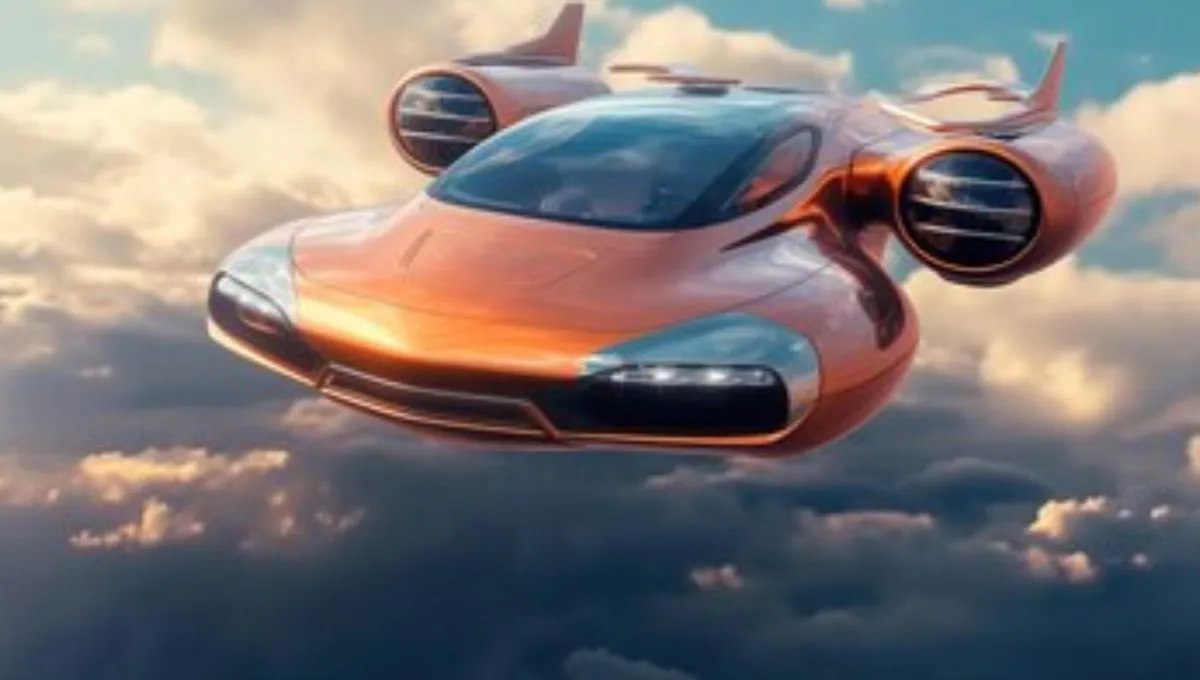Introduction
The age where Flying Cars 2024 become mainstream reality will arrive. Driving through traffic while flying overhead seems like a science fiction fantasy that is now turning into reality. Science no longer presents this technological concept as science fiction. Cable news shows The Jetsons alongside movie Back to the Future have given way to the reality of flying cars thanks to AI progress alongside improvements in aviation technology and battery technology. These flying vehicles will remodel the way society moves its people from one place to another.
This article examines modern flying car technology developments while assessing upcoming obstacles before predicting their potential entry into aerial traffic.
The Dream of Flying Cars: A Sci-Fi Fantasy Turning Real

Remember The Jetsons? Or Back to the Future? The residents of these worlds experienced flying cars making daily trips in their ordinary lives. The science fiction concept served as motivation for engineers to pursue airborne vehicle designs in reality. Personal aircraft design ideas existed during the 1900s among the pioneering inventors. Weak technology along with inadequate lightweight batteries and restricted propulsion capabilities prevented the product from reaching market success. Various technological advances like VTOL systems combined with AI along with compact drones have made Flying Cars 2024 possible.
How Do Flying Cars Work?

VTOL Technology
To function as flying automobiles most modern inventions include Vertical Take-Off and Landing (VTOL) features. The design allows these vehicles to depart helicopter-style without needing any runway. The lack of runway needs enables better city transportation.
Propulsion Systems
Different flying car versions implement jet motors or electric propulsion systems based on drone motor technology. Short-distance urban transportation is the priority design point for these aircraft engines.
AI and Autonomous Controls
The implementation of artificial intelligence becomes essential across navigational aspects and route computation and safety measures which operate flying cars. The use of AI results in improved flying performance because it prevents human mistake and delivers a more consistent user journey. Following recent advancements in technology Flying Cars 2024 are entering the market.
The Current State of Flying Car Technology

Companies Developing Flying Cars 2024
Various corporations are currently competing to take the first position in the Flying Cars 2024 market. The industry contains established corporations together with upcoming companies that advance in the field.
- Aero Mobil (Slovakia): Converts from car to aircraft in 3 minutes.
- Terrafugia (USA which belongs to Geely): The FAA has already approved the “Transition” prototype for its test flight operations.
- PAL-V (Netherlands): Focuses on gyrocopter-style vehicles.
- Hyundai partnership with Uber Elevate: It seeks to establish air taxi services for city transportation needs.
- Joby Aviation & Lilium: Leaders in the eVTOL (electric VTOL) segment.
Each company has performed successful test flights demonstrating the validity of this movement.
Prototypes and Test Flights
Real flying car products Air Car, Volo copter and EHang 216 have undergone successful flight demonstrations. The developed flying machine prototypes display an example of future urban air mobility systems.
Testing of flying cars remains promising yet significant technological development over both land and air domains is needed to establish flying cars as daily fixtures. The current Flying Cars 2024 era has started through initial demonstrations of flying vehicles.
The Biggest Challenges to Its Becoming Mainstream

Technological Limitations
Electric batteries at the present time need more energy density to enable long-distance flight capability. The development of better technology behind this technology stands as an essential requirement for establishing practical Flying Cars 2024.
Safety Concerns
Mid-air collisions? Malfunctions? Emergency landings? The path to riding a flying car requires that this technology meets all safety requirements under strict testing standards. Following recent advancements in technology Flying Cars 2024 are entering the market.
Regulations and Legal Barriers
Who manages airspace? What’s the rule for flying over private property? Governments haven’t caught up yet. Regulations are in development, but it’ll take time.
Who manages airspace? What guidelines exist to allow aircraft to cross over personal properties? Governments haven’t caught up yet. Regulations remain under development while the necessary time for their completion extends. Following recent advancements in technology Flying Cars 2024 are entering the market.
Cost and Accessibility
Models from the early creation period came with price tags reaching from $300,000 to $1 million which puts them well out of reach for Uber replacement options. Mass adoption needs affordable production. Following recent advancements in technology Flying Cars 2024 are entering the market.
The Role of AI and Automation

Flight Navigation and Autonomy
The AI systems assist flying cars through route planning and keep watch for potential obstacles to decide quick safety responses. The goal? Human beings should not require a commercial pilot license before operating an aircraft.
Reducing Human Error
Autonomous flight technologies eliminate safety risks generated by drivers who do not concentrate or lack flying experience. The age where Flying Cars 2024 become mainstream reality will arrive.
Environmental Impact: Are Flying Cars Sustainable?

Electric vs Fuel-Powered Models
Electric VTOLs emit zero CO2 during flight. But fuel-powered models? Not so much. The industry is heading towards sustainability yet it remains unfinished work. The development of Flying Cars 2024 depends significantly on sustainability measures because they will determine future widespread adoption.
Emission & Waste Management
The production of batteries together with their disposal period produces detrimental effects on the environment. Complete sustainability in air travel requires eco-friendly manufacturing at its core.
When Will This Cars Become a Reality?

Expert Predictions and Timelines
According to most industry experts commercial flying car services will start operations in 2026-2028. For personal vehicles? Expect wider adoption after 2035. The age where Flying Cars 2024 become mainstream reality will arrive.
Steps Before Mass Adoption
- Infrastructure: The future will need sky terminals as well as electric energy recharging points together with aerospace management systems.
- Public Trust: People need to feel safe flying in (or next to) these machines. To achieve broad market acceptance people, require assurance that the machines are fit for flight as well as proximate flight.
- Legal Frameworks: Governments need to create regulations immediately because they represent the last barrier facing the new transport layer.
How Will This Cars Change Our Lives?

Reduced Traffic and Travel Time
No more sitting in bumper-to-bumper traffic. Flying automobiles will significantly decrease the amount of time needed for your daily commute.
Greater Urban Mobility
Planned urban transport routes would enable highly efficient movement between rooftops in cities.
Job Creation and Industry Growth
Transportation sector development will result in job creation that includes manufacturing along with piloting and traffic control and maintenance services. The age where Flying Cars 2024 become mainstream reality will arrive.
Potential Risks and Downsides of Flying Cars

Air Congestion
The projected aerial space becomes filled rapidly. Advanced systems have to be developed in order to prevent an air congestion crisis.
Privacy and Security Threats
Cybersecurity risks from hackers combined with surveillance operations and air accidents make up a brand-new category of extraordinary security threats.
Economic Disparity
The continued high cost of flying cars will create an increased social division where the wealthy separate themselves from the general population.
Conclusion
The world has passed beyond seeing flying cars as a fantasy. This technology development process is truly underway at the present moment. The future progress for personal flying automobiles is currently in development. Following recent advancements in technology Flying Cars 2024 are entering the market. The realization of passenger-carrying aircraft as regular elements in our urban environment seems attainable with present technological advancements and proper statewide policies and developing networks.
FAQs
1. Are flying cars real or just a concept?
They’re real! Prototypes are flying today. The testing process continues while the vehicles remain unavailable to commercial customers.
2. How much will a flying car cost?
The currently available flying cars span from $300,000 to more than $1 million in worth. Price reductions will occur because of mass production facilities.
3. Can anyone drive a flying car, or will they need a special license?
You would need to acquire a combined license containing elements of drivers and pilot’s credentials depending on your regional standards.
4. Will flying cars replace regular cars?
Not in the near future. Flying cars will operate complimentary to ordinary vehicles especially when used in congested metropolitan areas or specific transportation routes.
5. Which country is leading in flying car technology?
Joby EHang Volo copter together with the USA, China and Germany along with Slovakia currently steer the development of Flying Cars 2024 technologies.






